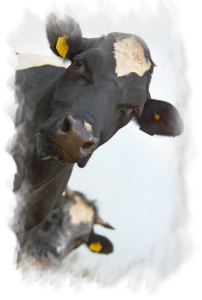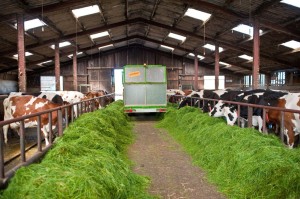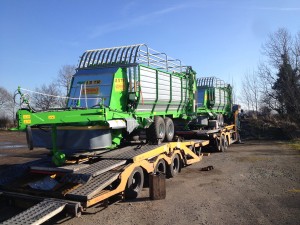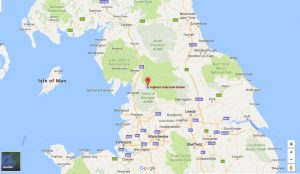At the end of July Farmers Weekly published an article on Mr. Derek Haworth and the way he is making the most of one of our zero grazing forage wagons .
Many people believe it is not possible to successfully combine robotic milking of dairy cows with high milk yields from grass. One Lancashire dairy farmer is proving it can be done.
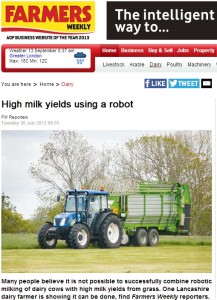
Derek Haworth using a Bonino Forage Wagon
Derek Haworth has lived and worked at Rose Farm near Blackpool, since 1979. But he only started looking at robotic technology for use in his 70-cow herd in in 2002.
About 70 registered Holsteins, Ayrshires and crossbred cows are milked on the tenanted, 45ha farm with an extra 8-16ha rented each year depending on availability.
Average annual milk yield has reached 8,476 litres a cow of which typically 4,000 litres comes from forage, although in 2012 appalling weather meant that this dropped to 3,230 litres, still impressive when compared to a national average of around 2000 litres.
Robotic milker
Although Mr Haworth looked at robots more than 10 years ago it wasn’t until seven years later he felt confident enough in their reliability to buy his robotic milker. “I had always wanted to try milking with a robot, but the question was could I make it work with a forage system?”
The answer is a definite yes, says Mr Haworth. “Cows are grazed day and night using an A and B pasture system but this is supplemented with zero grazed grass every day and silage when necessary,” he says. A pasture gate from the housing leads to a fresh “A” paddock each morning, the “B” night paddock is more of a loafing area and this is where the zero grazing comes in.
Mr Haworth cuts and collects in one pass with his zero grazer, the same machine then dispenses the fresh grass down the feed barrier. This is done at 4-5pm each day, when the sugar content is highest and the cows all come in from their day pastures to feed. “There are only a few days, when they are on lush, fresh spring grass that I have to go and get them,” says Mr Haworth.
“The zero grazer works 365 days a year because in winter it feeds my silage too, although I always break blocks of silage open on the floor to loosen it up before putting in the machine. Zero grazing is a very efficient way of using your grass because there is so little waste compared to grazing.”
No concentrates are fed down the trough. Cake is fed through the robot and via out of parlour feeders (OPF), but built up slowly after calving to maximise forage intakes and prevent digestive/health problems.
After calving 2kg of cake is fed in the robot and 1kg in the OPF. Mr Haworth slowly builds the cows up over 35 days to a maximum of 10kg in the OPF and 6kg in the robot if they reach 50 litres.
Below this a maximum of 8kg is fed in the OPF and reduced further if cows are under pressure. The OPFs mean the feed is used efficiently. “To maximise milk from forage I use a very high quality cake, but I control where every single kilogramme goes,” he says.
Duncan Rose, Carrs Billington’s chief technical officer adds: “the concentrate feeding strategy during the dry period to calving and through the first month after calving is absolutely crucial and often not given enough attention on some farms, but Derek totally understands and practices this.
What will be a surprise to many is that no concentrates are fed in the dry period, but individual cows can be allocated up to 16kg a day. But, and it is a crucial but, the rate of increase from calving is very carefully and individually controlled to each cow or heifer,” he says.
The current 12-month rolling feed rate is 0.31kg/litre, but it has been as low as 0.24kg/litre. There are no moist feeds or “other purchased feeds used and the rolling purchased feed costs per litre are around 3ppl below the average.
Generally, three cuts of silage are made, sometimes four, as this fits in with the zero grazing. No artificial fertiliser is used except to give a field a short term boost, Mr Haworth says. “I am not organic, I just don’t fertilise or spray as much, but this is done for financial not political reasons. My system is sustainable not intensive.”
Heifers
Mr Haworth rears his own heifers which calve at between 2 and 3 years of age, depending on size and maturity. Replacement rates are low with only 10 -12 heifers brought in each year, this means surplus heifers can be sold.
Dutch genetics are generally sourced to breed replacements, mostly red and white Holstein or Ayrshire, but occasionally a black and white test bull is used.
Heifers are served with an Aberdeen Angus to give them an easy calving and a Limousin on cows not used to breed replacements. Beef and bull calves are sold off at 6 to 8 weeks through the local market.
A 365-day calving interval is aimed for, but service time depends entirely on the animal and if a cow is under the weather, or needs more time to recover from calving, then service is delayed. The actual calving interval is 418 days for the Holsteins and 398 days for the Red and Whites.
Milk is sold to Butlers Farmhouse Cheeses on a constituent contract. Milk quality is very important here, particularly protein and the current rolling 12-month figures are 4.48% butterfat and 3.30% protein.
Mr Haworth believes there is no need to expand cow numbers beyond 70-plus followers. “Most herds typically run around 70 cows milked for every full-time employee and if I expanded it would need a huge jump in cow numbers, land rented and infrastructure costs to provide enough work to justify another employee. My aim and philosophy has been to devise a system to achieve each cows economically sustainable genetic potential.”
Article Farmers Weekly
 Green Forage enjoyed an amazing day at the first Cheshire Ploughing and Hedgelaying Match the company has attended. Interest in the Bonino range of grazer wagons from farmers keen to reduce input costs was fantastic. Thank you to all those who came to chat to us and especially to Stuart and Charles who visited the stand and chatted about their experience of working with the grazer wagons (Stuart for 13 years!). We hope to see you all next year.
Green Forage enjoyed an amazing day at the first Cheshire Ploughing and Hedgelaying Match the company has attended. Interest in the Bonino range of grazer wagons from farmers keen to reduce input costs was fantastic. Thank you to all those who came to chat to us and especially to Stuart and Charles who visited the stand and chatted about their experience of working with the grazer wagons (Stuart for 13 years!). We hope to see you all next year.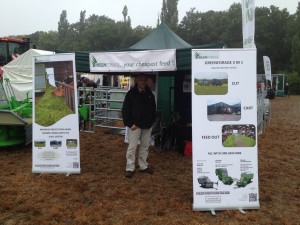

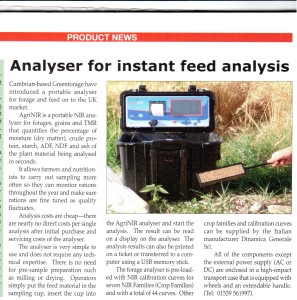


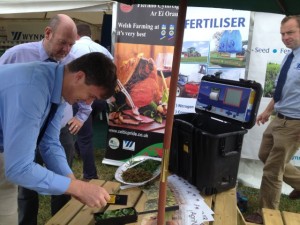
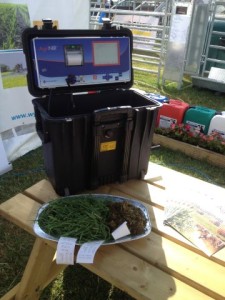
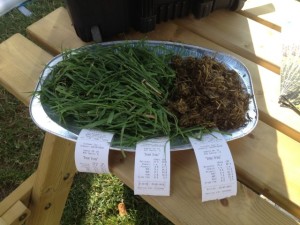
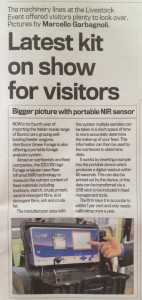
![agrinir[2]](https://www.greenforage.co.uk/wp-content/uploads/2013/01/agrinir2.jpg)

